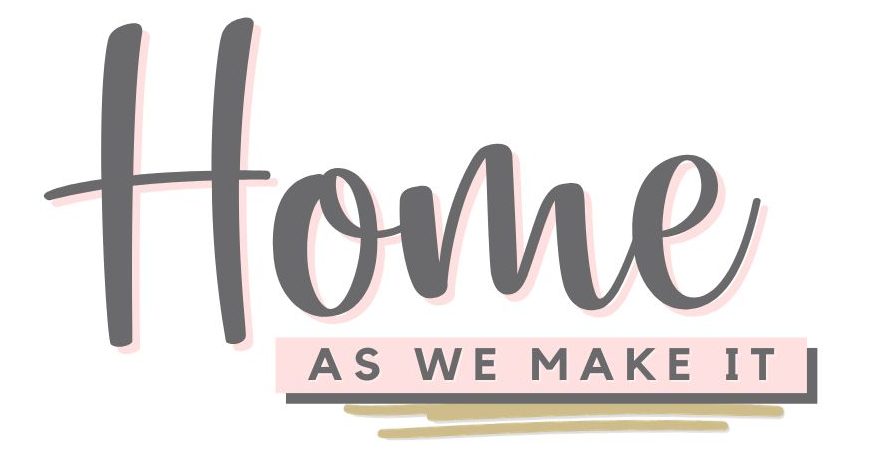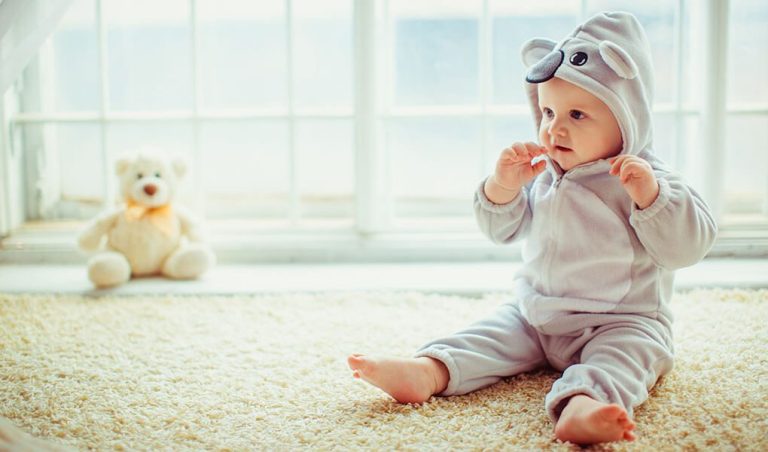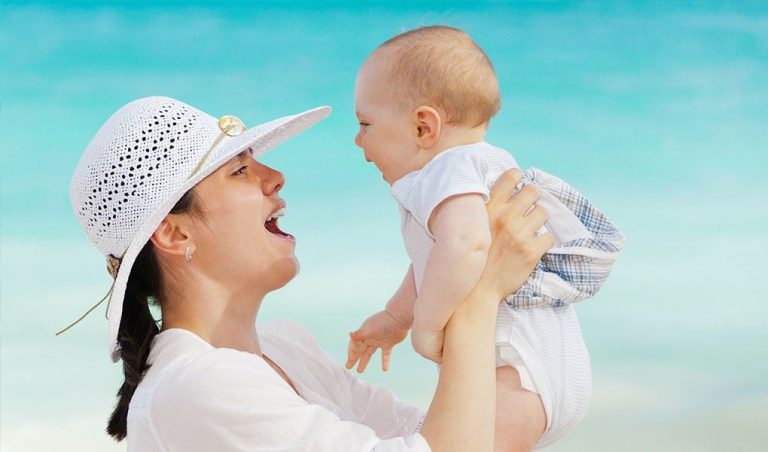Safeguarding Your Newborn: An Introduction To Infant Safety At Home
From safe sleeping arrangements to proper hygiene practices, there are many things you can do to safeguard your newborn’s well-being.
In this article, we will provide you with an introduction to infant safety at home. We understand that as a new parent, it can be overwhelming to navigate through the dos and don’ts of keeping your baby safe. That’s why we’ve compiled some important information and tips that will help you feel more confident in taking care of your newborn.
Note: This post may contain affiliate links, which means if you buy from my link I might make a small commission. This does not affect the price you pay. See the full affiliate disclosure here.
Let’s dive in!

Safe Sleeping Arrangements
Make sure your little one sleeps soundly by creating a cozy and secure sleeping environment.
Co-sleeping dangers are something to be aware of, so ensure that your baby is sleeping on their back in their own crib or bassinet, free from any soft bedding or pillows.
Swaddling techniques can also help soothe your newborn and prevent them from waking up due to startle reflexes. When swaddling, make sure the blanket is snug but not too tight around their chest and hips. Keep their arms tucked in with only their head exposed.
It’s important to know when to stop swaddling as well – once your baby starts showing signs of rolling over or trying to break out of the swaddle, it’s time to transition them out of it for safety reasons.
By following these guidelines, you can create a safe sleeping environment for your little one and ease any worries about their well-being while they sleep.
Baby-Proofing Your Home
To ensure the safety of your little one, it’s essential to baby-proof your home.
Start by identifying potential hazards such as sharp corners and objects that can be swallowed.
Next, secure electrical outlets and cords to prevent electrocution or strangulation.
Finally, install safety gates and locks on cabinets and drawers to keep curious little hands away from hazardous items.
Remember, taking these simple precautions can go a long way in safeguarding your child’s well-being at home.
Identifying Potential Hazards
As you scan your living space, keep an eye out for any objects or areas that could pose a threat to your little one’s well-being. Start by identifying potential choking hazards such as small toys, coins, and even food items like grapes or nuts. Once you’ve identified these hazards, make sure they’re kept out of reach of your child.
Another important step is to identify poisonous substances in your home. This includes cleaning products, medications, and even plants that may be toxic if ingested. Keep these items stored securely out of reach and consider using child-resistant locks on cabinets or drawers where they’re kept.
By taking these precautionary measures, you can help ensure that your newborn remains safe and healthy in their new home environment.
Securing Electrical Outlets and Cords
Securing electrical outlets and cords is crucial for keeping your little one out of harm’s way. Be sure to check all exposed sockets and cords around the house. Outlet covers are a simple solution to prevent curious fingers from getting shocked or burned. Ensure that all unused outlets are covered with child-safe outlet covers, and replace any damaged or missing ones immediately.
Cord management is also important in preventing accidents. Keep cords hidden behind furniture or use cord clips to secure them along walls and baseboards. Avoid using extension cords whenever possible, but if necessary, make sure they’re properly secured and not creating tripping hazards.
Remember, taking these precautions now can save you from potential danger later on.
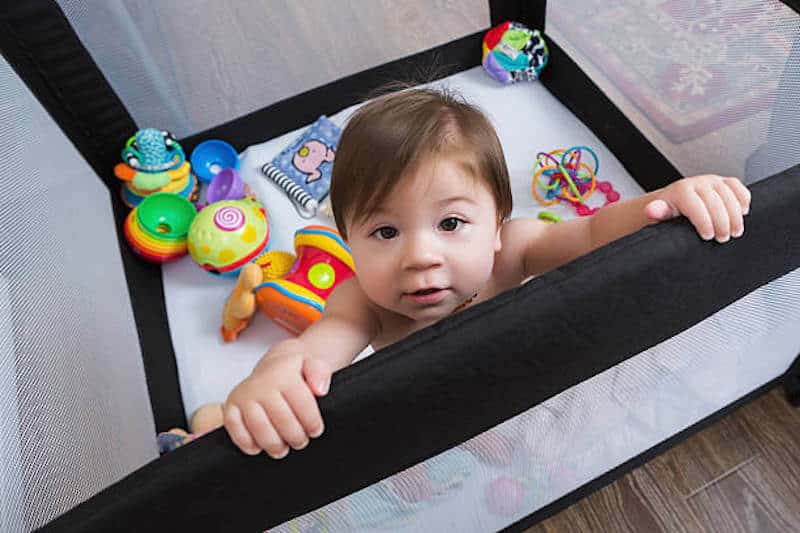
Installing Safety Gates and Locks
You’ll want to put up safety gates and locks throughout your house to keep your little one out of dangerous areas. As soon as your baby starts crawling, they can quickly get into trouble by exploring their environment without any sense of danger.
With the help of safety gates, you can create a secure environment for your baby and have peace of mind while you go about your daily routine.
When it comes to choosing the right type of gate, there are several options available in the market. Depending on where you want to use them and how long you plan on using them, you can opt for pressure-mounted or hardware-mounted gates.
Pressure-mounted gates work best when used in doorways or between rooms but may not be suitable for staircases as they tend to wobble with time. On the other hand, hardware-mounted gates require drilling holes into walls or banisters but provide a more secure fit that won’t shake loose over time.
Once you’ve chosen the right type of gate, it’s essential to choose a lock that is easy enough for adults to operate but difficult enough for children to figure out. Keeping these factors in mind will help ensure that your little one stays safe and sound at home.
| Emotion | Example | Explanation |
|---|---|---|
| ——— | ——— | ————- |
| Fear | “Without a proper safety gate installed at the top and bottom of stairs, your child could easily fall down them.” | This example evokes fear by highlighting what could happen if proper precautions aren’t taken |
| Relief | “Installing safety locks on cabinets containing hazardous materials will give you peace of mind knowing that your child cannot access them.” | This example evokes relief by providing a solution to parents’ worries about keeping potentially harmful items out of reach |
| Responsibility | “As parents, it’s our duty to ensure our children’s safety at all times.” | This example evokes responsibility by reminding parents that they have a crucial role to play in protecting their children from harm. |
| Love | “By securing your home with safety gates and locks, you’re showing your child how much you care about keeping them safe.” | This example evokes love by highlighting the lengths parents will go to protect their children and keep them out of harm’s way. |
| Empathy | “As a parent, it can be overwhelming to think about all the potential dangers in our homes. That’s why installing safety gates and locks is such an important step towards creating a safer environment for our little ones.” | This example evokes empathy by acknowledging that parenting can be challenging and recognizing the importance of taking steps to mitigate risks at home. |
Handling and Transporting Your Newborn
When it comes to handling and transporting your newborn, there are a few key points to keep in mind. First and foremost, proper holding techniques are essential for keeping your baby safe and comfortable.
Additionally, using a car seat that is appropriate for your child’s age and size can help ensure a safe ride.
Finally, it is crucial to avoid shaking your baby in order to prevent the serious condition known as Shaken Baby Syndrome.
As you navigate this exciting new chapter in your life as a parent, remember that taking these precautions can go a long way towards protecting your precious little one.
Proper Holding Techniques
Holding your little one can be a bit nerve-wracking at first, but with the right techniques, it can become second nature. Proper positioning is key to ensuring that you and your baby are comfortable during holding sessions.
It’s important to keep your newborn’s neck and head supported at all times, especially in the first few months of life when their muscles are still developing. Here are some tips for proper holding techniques:
- Cradle hold: Support your baby’s head and neck with one hand while using the other arm to cradle them against your chest.
- Football hold: Place your baby on their side, facing you with their legs tucked under your arm like a football. Use one hand to support their head and neck while keeping their body close to yours.
- Belly hold: Hold your baby face down across your forearm with one hand supporting their chest and the other supporting their diaper area.
- Shoulder hold: Place your baby on one shoulder while supporting their bottom with one hand and patting or rubbing their back with the other.
Remember, always make sure that both you and your little one are comfortable during these holding sessions. With practice, these techniques will become second nature!
Safe Transportation in a Car Seat
Make sure your little one is secure and safe during car rides by properly installing and using a car seat. Car seat installation is crucial to ensure that your baby is protected in case of an accident. Always read the manufacturer’s instructions carefully when installing the car seat, and make sure it fits tightly in your car.
You should also check that the straps are adjusted correctly for your baby’s size and weight. Choosing the right car seat is equally important. There are different types of car seats available depending on the age, height, and weight of your baby.
Make sure to choose a rear-facing infant seat for babies under one year old, as this provides more protection for their head, neck, and spine in case of a crash. As your child grows older, you can switch to a front-facing or booster seat until they are tall enough to use a regular seat belt.
Remember that safety always comes first when it comes to transporting your little one!
Avoiding Shaken Baby Syndrome
You can prevent serious brain injury by never shaking your baby, even in frustration or anger. Shaken Baby Syndrome (SBS) is a serious form of abuse that occurs when someone shakes a baby violently, causing their brain to move back and forth inside their skull.
This can cause bleeding in the brain and eyes, leading to lifelong disabilities or death. In fact, SBS is the most common cause of death from child abuse.
It’s important to recognize the symptoms of SBS so you can seek help as soon as possible. Symptoms may include vomiting, seizures, difficulty breathing, limpness or rigidity, and loss of consciousness.
If you suspect that your baby has been shaken or abused in any way, seek medical attention immediately. Remember that it’s okay to ask for help if you feel overwhelmed or frustrated with caring for your newborn. There are resources available to support new parents and ensure the safety of their children.
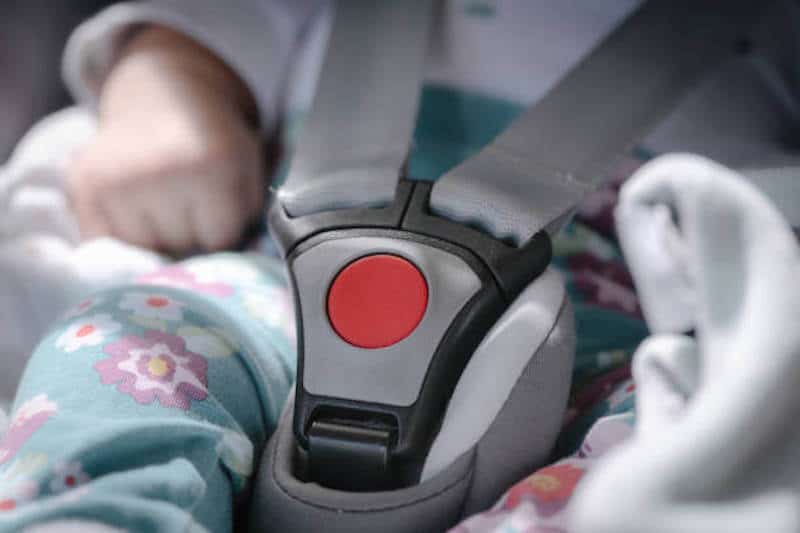
Bathing and Hygiene
When it comes to keeping your little one clean and fresh, bathing and hygiene are essential. As a new parent, it can be overwhelming to choose gentle, fragrance-free products specifically designed for babies. It’s important to look for products that have been tested by pediatricians and avoid those that contain harsh chemicals or irritants.
You’ll also need to decide whether to give your baby sponge baths or tub baths. Sponge baths are recommended for the first few weeks of life until the umbilical cord stump falls off. After that, you can start giving your baby tub baths. Always make sure the water temperature is warm but not hot, and never leave your baby unattended in the bath.
With proper bathing techniques and product choices, you can help keep your little one clean and healthy while creating special bonding moments at bath time.
Monitoring Your Newborn’s Health
Keeping an eye on your baby’s health is crucial in the first few weeks, and there are simple ways to monitor their well-being that you can easily incorporate into your daily routine.
One of the most important things to keep track of is your newborn’s weight gain. In the first few days after birth, it’s normal for babies to lose some weight as they adjust to their new environment. However, after this initial period, they should start gaining weight steadily.
You can monitor this by weighing them regularly and keeping track of their progress. Breast milk production is another important factor in monitoring your newborn’s health.
If you’re breastfeeding, it’s important to make sure that your baby is getting enough milk. Signs that they may not be getting enough include fussiness or lethargy after feedings, infrequent wet diapers, or slow weight gain.
If you have concerns about your breast milk production or your baby’s feeding habits, don’t hesitate to contact a lactation consultant or pediatrician for guidance and support. By staying attentive to these key factors in your newborn’s health, you can help ensure that they’re thriving in their new world.
Conclusion
By taking proactive measures, such as safe sleeping arrangements, baby-proofing your home, and practicing proper handling and transportation techniques, you can provide a secure environment for your little one.
In addition to these preventative measures, regular monitoring of your newborn’s health is crucial. This includes maintaining good hygiene through bathing and diaper changes, keeping an eye out for any signs of illness or discomfort, and following up with pediatrician appointments as recommended.
By staying informed and taking necessary precautions, you can help ensure that your newborn stays healthy and happy in their new home.
